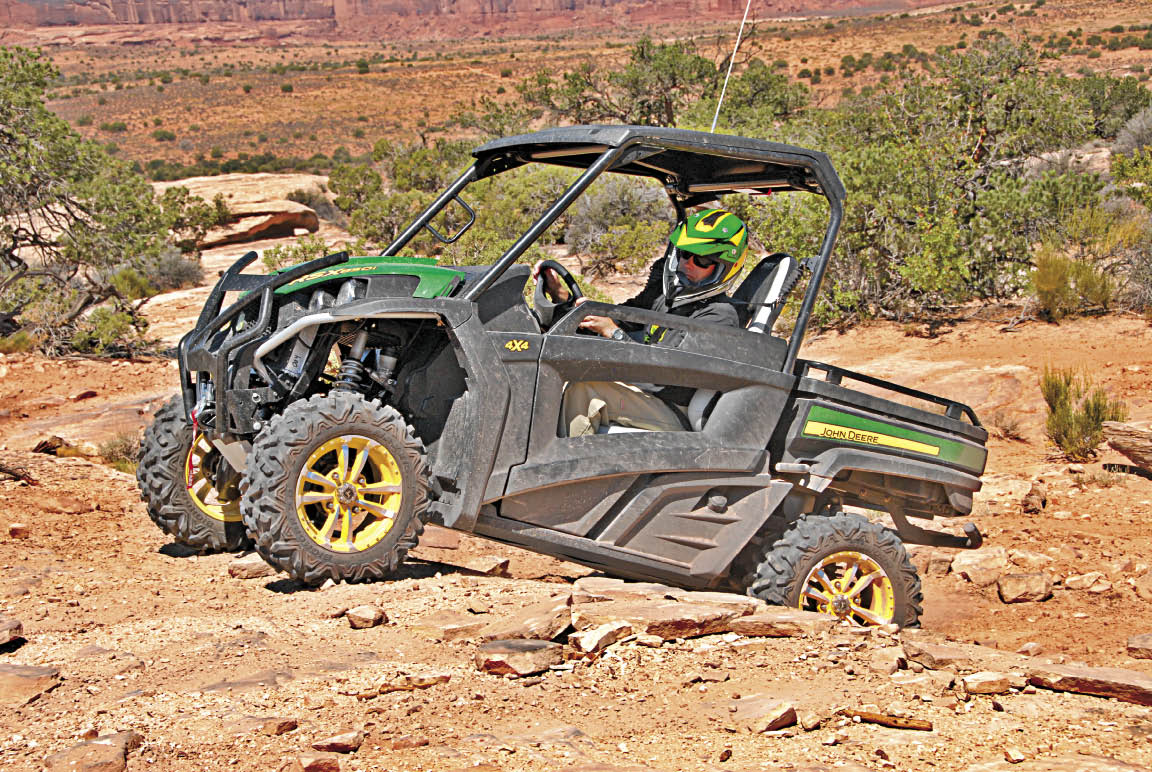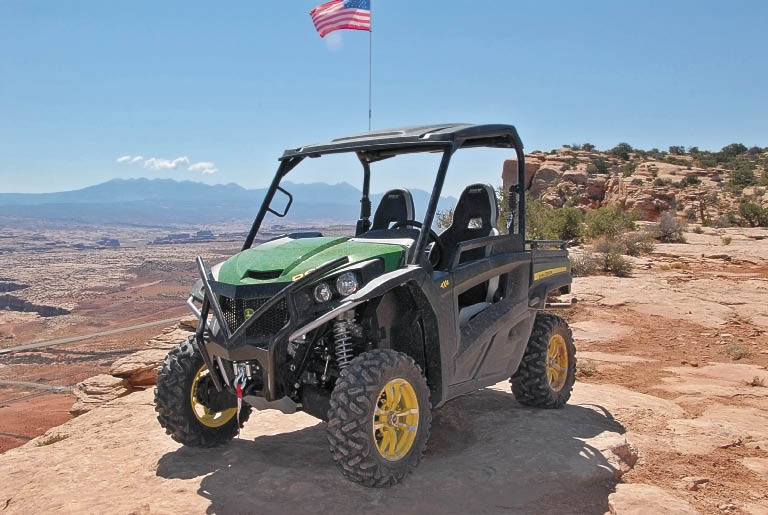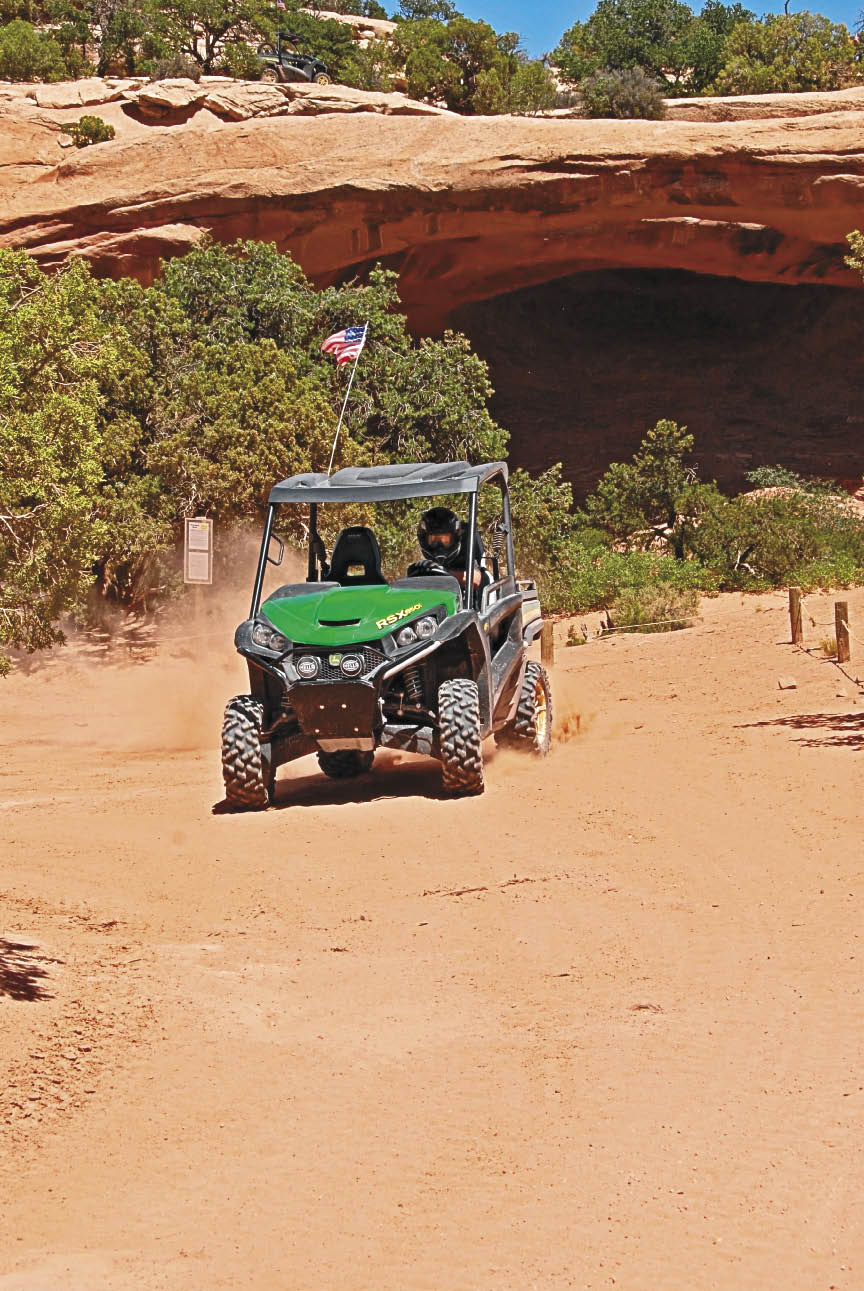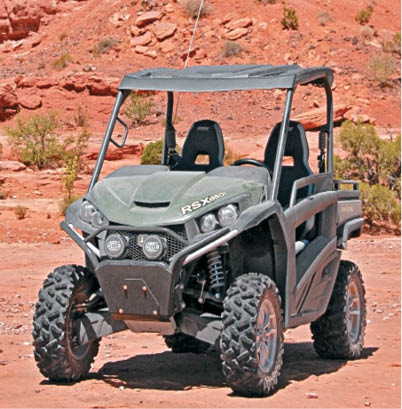 Maybe we're reading too much into this, but we're thinking John Deere's choice to go to Moab, UT, in July during the heat of summer was an effort to send a subliminal message about its all new Gator RSX850i side-by-side.
Maybe we're reading too much into this, but we're thinking John Deere's choice to go to Moab, UT, in July during the heat of summer was an effort to send a subliminal message about its all new Gator RSX850i side-by-side.
Perhaps the message Deere was trying to send is the new RSX850i is the hottest side-by-side the company has ever built. Can't argue with that. It's definitely the first pure recreation-type side-by-side the company has built.
Or maybe the message the company wanted to send is that it thinks the RSX850i will be one of the hottest side-by-sides on the market for the 2013 model year. That would be quite a statement coming from Deere, whose Gators have traditionally been more agriculture- and landscaping-oriented vehicles. The jury is still out for us on that one-mostly because we haven't driven all the 2013 side-by-side models yet. We will say it's definitely in the ballpark with its other recreation side-by-side competitors.
 Not so subliminal was the fact that John Deere wants a piece of the recreational side-by-side market, easily the hottest segment in off-road motorsports. How hot you say? Side-by-sides are projected to pass ATVs in sales by the end of this year.
Not so subliminal was the fact that John Deere wants a piece of the recreational side-by-side market, easily the hottest segment in off-road motorsports. How hot you say? Side-by-sides are projected to pass ATVs in sales by the end of this year.
"We see industry growth," Dave Gigandet, John Deere's marketing manager for Gator utility vehicles, said in referring to the side-by-side segment. Here's our translation: John Deere wants a piece of the pie.
10,000 Testing Hours
"It took us a long time to develop a product we felt comfortable about releasing to consumers," Gigandet said. He explained John Deere invested 10,000 hours of field testing in the RSX850i before its release.
The end result of all that market research and subsequent vehicle testing is the RSX850i, which, in a way, completes the leap from Deere's more traditional Gators to the recreation segment. It's fitting, too, perhaps in light of the fact that 2012 marks the 20th anniversary of the Gator brand.
To achieve a recreation-type side-by-side, John Deere had to go back to the drawing board and come up with a completely new vehicle, including the chassis, suspension, transmission-darn near everything. The RSX is built on an all-new mid-size chassis and "shares only a few components with other John Deere Gators," Gigandet said. He explained, "The engine, transmission, differentials and much of the suspension are unique to the RSX. Some portions of the cargo box, operator's station and frame were co-developed with the recently introduced XUV550 so we were able to share some of those pieces."
He pointed out, however, that virtually nothing is shared with the 825i or 855D vehicles that some folks are familiar with.
"We knew that we needed to start with a nimble, lighter weight platform than we would have been able to get by creating a derivative from those larger machines," Gigandet said.
Head On Into Recreation Segment
 The new RSX850i is an impressive vehicle, especially considering it's John Deere's first real move into the recreational side-by-side market. There's not one single component or feature we like more than others; rather, it's a combination of power, ride and ergonomics that make it so much fun to ride.
The new RSX850i is an impressive vehicle, especially considering it's John Deere's first real move into the recreational side-by-side market. There's not one single component or feature we like more than others; rather, it's a combination of power, ride and ergonomics that make it so much fun to ride.
John Deere collaborated with design and engineering consultants for Formula One and NASCAR to help recreate the RSX, which is available in three models: RSX850i Sport (designed for harsh desert and rocky, sandy terrains); RSX 850i Trail (designed for hunting, fishing and backcountry trails); and the base RSX 850i.
For its powerplant, John Deere is partnering with Italian scooter maker Piaggio, which helped create a powerful (a claimed 62 hp and 59.5 lb. feet of torque) 839cc OHV liquid-cooled V-twin with a closed-loop EFI system. The engine-the largest displacement gas engine in any Gator-utilizes an industry-exclusive electronically-controlled engine oil cooler, which was a handy feature during our test ride in Moab. Did we mention it was hot when we test drove the RSX? Try 99-101 degrees F as we crawled over the rocks, across the dirt, sand and slickrock on the Sevenmile Rim Trail.
It was actually pretty gutsy for John Deere to choose Moab in July to introduce their RSX to the media. They certainly could have chosen a place with more forgiving terrain that was not so blisteringly hot. The RSX held up well in Moab's punishing terrain and heat.
We would describe the engine's power delivery as smooth, rather than hard-hitting, which is kind of weird because when we put one of John Deere's claims to the test-that the vehicle will go from 0-30 mph in 3 seconds-the power built quickly but not "jerky." Just to be clear, we didn't have a stop watch when we mashed the gas pedal to see how long it took to get to 30 mph, but we're sure it was darn close to that. We also got close to the claimed top speed of 53 mph in a rock-strewn wash and were again impressed with the responsiveness of the engine.
Going fast wasn't a problem but slowing down was. The brakes felt really soft to us and we never did get quite used to them during our day ride in Moab. More seat time will tell us if indeed the brakes are soft or it's simply the "throw" of the pedal, meaning you have to push it pretty far down to get reaction.
Power To The Ground
The power gets to the wheels thanks to a Team Industries tight belt CVT. We think the RSX was clutched well for the varied conditions we encountered in Moab. Our wish list for the RSX would be a gear indicator on the dash/gauges. That way the driver wouldn't have to look down to see what gear he's in. What compounds that small issue is that it takes a little effort to find the gears, especially between high and low. Like we said, it's not a big issue, just an annoyance.
Not annoying was the ride. The four-wheel independent suspension worked well in Moab's challenging conditions-a great place to test whether a suspension is not just going to hold up but provide a nice ride as well. The front suspension is a double A-arm with coil-over shocks and an anti-sway bar and 9 inches of travel. In the back is a multi-link semi-trailing double A-arm also with coil-over shocks and anti-sway bar and 9 inches of travel. Fox aluminum body monotube shocks are standard on the base and Trail RSX models, while the Sport model gets Fox 2.0 Performance Series shocks with full spring and compression adjustability.
The rougher it got the more the RSX suspension shined. We did spend more time in the Sport RSX and so our ride was probably a little more plush than the Trail, but Fox knows a thing or two about shocks so all RSX vehicles should ride well. There was one section on the Sevenmile Rim Trail where we rode through a wash littered with rocks, sand, dirt and hard edges. The Sport ate the whoops up as we hammered through the wash at a pretty good clip-40 plus mph. The rear end stayed put, never really getting out of shape as we thumped the bumps. Nothing is more unnerving than the rear end of your vehicle getting out of shape as you negotiate the bumps. That wasn't an issue with the RSX.
Controlled Landing
 One feature on the RSX that provides even more confidence for the driver is an ECU that senses wheel speed. Gigandet explains how this ECU works and its benefits.
One feature on the RSX that provides even more confidence for the driver is an ECU that senses wheel speed. Gigandet explains how this ECU works and its benefits.
"The ECU monitors ground speed and acceleration," he said. "When it sees an abrupt/sudden increase in wheel speed (an acceleration) it assumes the wheels have come off the ground. Think of the operator going over a jump and not letting up on the gas pedal. When the wheels leave the ground, they speed up almost instantly.
"The ECU will then cut spark and fuel for a period of time which in turn decreases the engine's power and torque output. The amount of time with limited output is based on the ground speed of the vehicle before the sudden acceleration happened. This brief period of time with limited output slows the wheels down to a point closer to what they were going when they left the ground."
And the benefit of that? "First, we get a more controlled landing for the machine," he explained. "The rear wheels aren't spinning when they hit the dirt so they tend to stay planted instead of skidding around. Second is the protection that is provided for the drivetrain and tires. If the tires were allowed to spin at high speed under no load while in the air and then the tires were driven into the ground while still under power, a large shock load is driven through the entire driveline. Shock loads are some of the hardest on the components of a machine. We believe that this system will help the RSX provide years of reliable, durable enjoyment to our customers by reducing/avoiding these damaging shock loads."
 The RSX doesn't have power steering but instead is equipped with an automotive-type rack and pinion steering system and Ackerman steering design. We've long been cheerleaders for power steering, but the RSX not having PS is much less noticeable than in some competitors' side-by-sides.
The RSX doesn't have power steering but instead is equipped with an automotive-type rack and pinion steering system and Ackerman steering design. We've long been cheerleaders for power steering, but the RSX not having PS is much less noticeable than in some competitors' side-by-sides.
We wish we had a little more space to talk about the other components of the RSX we like, such as the seat, storage space, good looks and more, but we'll provide a long term review after we get some more seat time in our demo unit.
John Deere is now a player in the recreational side-by-side segment and we imagine the RSX will be a hot ticket item in John Deere dealerships across the country.
Engine: OHV, 4-stroke, V-twin
Displacement: 839cc
Fuel System: EFI
Cooling: Liquid
Fuel Capacity: 7.4 gallons
Transmission: CVT with high, low, neutral, reverse
Drive System: On-demand 2WD/4WD with selectable limited slip and full locking front differential
Front Suspension: Independent, double A-arm with coil over shocks, anti-sway bar, 9 inches travel
Rear Suspension: Independent, semi-trailing double A-arm with coil-over shocks, anti-sway bar, 9 inches travel
Brakes: Hydraulic disc
Wheels: Alloy
Front Tires: 25x8-12 Ancla M-T (Extreme Terrain); Optional 26x8-14 Maxxis Bighorn 2.0
Rear Tires: 25x10-12 Ancla M-T (Extreme Terrain); Optional 26x10-14 Maxxis Bighorn 2.0
Wheelbase: 77.8 in.
Length: 119 in.
Width: 56.5 in.
Height: 72 in.
Ground Clearance: 10.3 in.
Dry Weight: 1,360 lbs.
MSRP: $12,999

